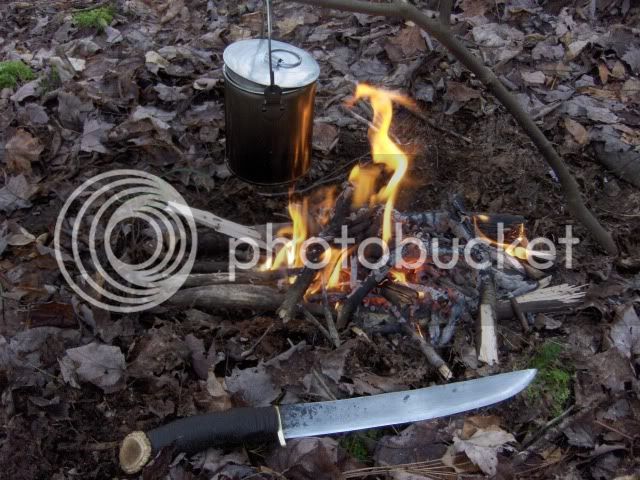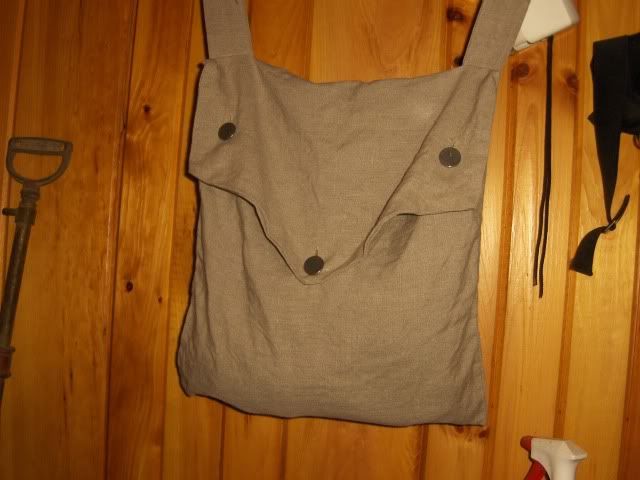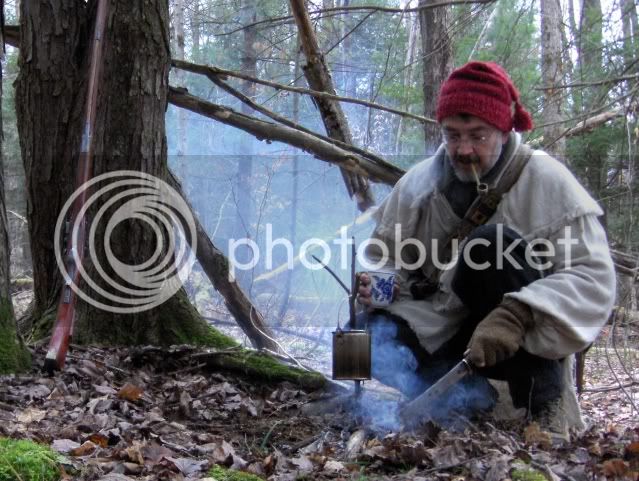Call it a "shoulder bag" and everyone will know what it is. In the time it took to get this far in the discussion, we could have made a bag. :haha:
-
Friends, our 2nd Amendment rights are always under attack and the NRA has been a constant for decades in helping fight that fight.
We have partnered with the NRA to offer you a discount on membership and Muzzleloading Forum gets a small percentage too of each membership, so you are supporting both the NRA and us.
Use this link to sign up please; https://membership.nra.org/recruiters/join/XR045103
You are using an out of date browser. It may not display this or other websites correctly.
You should upgrade or use an alternative browser.
You should upgrade or use an alternative browser.
what's in your haversack?
- Thread starter armedOkie
- Start date

Help Support Muzzleloading Forum:
This site may earn a commission from merchant affiliate
links, including eBay, Amazon, and others.
Stophel
75 Cal.
- Joined
- Jul 8, 2005
- Messages
- 5,963
- Reaction score
- 869
Carrying stuff...
Well, if you look closely at my little avatar, you can see that he is carrying a square shoulder bag with a triangular flap. This is from a Schwenkfelder catechism (Pennsylvania) dated Feb 1, 1787. Whether it represents the student himself (David Schultz), carrying his books in the bag, or just some man walking along picking apples, I don't know. I also don't know if the bag is supposed to be leather or cloth, but with the pointed flap, I would expect leather. Also note the universal German use of the walking stick. Men, women, children, all very often seen with walking sticks.
Now, most of my "studies" of period images is focused on things German, both in Europe and America. Other than this single example, I don't know that I have seen any other instance of an ordinary German civilian with a shoulder bag. Well, maybe one more, I'll have to dig and see if I can find it. I'm sure they were used here and there, of course. I do recall an English image of someone handing out handbills with the bills carried in a shoulder bag. I've also seen a scissor/knife seller carrying his wares in what appears to be a basketry "box" slung on a shoulder strap. It was certainly not an unknown concept, but packing around stuff in a fabric shoulder bag does not seem to have been that commonly done.
Up to the middle of the 18th century or so, it was nearly universal for military knapsacks to be of the one strap variety (worn more on the back than down by the side). After that, knapsacks began to be of the more familiar two shoulder strap variety. And I have read ample period references to non-military folks going out into the woods with their knapsack on their back (but not their haversack under their arm :wink: )
When I look at period illustrations of folks carrying things in general, like going back and forth to market, or in the case of the Salzburger Exulanten, being forced from their homes and trekking to Prussia (and some came to Georgia), I see snapsacks. Lots and lots of snapsacks. Sometimes, the "snapsacks" are just sheets of fabric (possibly blankets) with their belongings rolled up in them, with the ends of the sheet twisted and tied up into a "shoulder strap". I also see two-strap knapsacks (usually square, but sometimes of the "Alpin Ruecksack" variety). Pack baskets are also often found... though I have had people SWEAR that such things were NEVER used in Colonial America, as there is no proof of them here...
As a personal thing, I DETEST shoulder bags. Swinging around, swooshing in front of you every time you bend over even slightly, no matter how high or low you try to hang them. They are a pain. I don't even like a shoulder shot bag unless I can attach it to my belt to keep the stupid thing still! I have started to make myself a leather and hair-on goatskin knapsack, which I'll eventually finish in which to carry my "stuff". I have experimented with different things to see what works best for me, including blankets on a blanket sling ("tumpline" or "hoppus"), which is ok, but I have found a properly fitted knapsack works better.
Well, if you look closely at my little avatar, you can see that he is carrying a square shoulder bag with a triangular flap. This is from a Schwenkfelder catechism (Pennsylvania) dated Feb 1, 1787. Whether it represents the student himself (David Schultz), carrying his books in the bag, or just some man walking along picking apples, I don't know. I also don't know if the bag is supposed to be leather or cloth, but with the pointed flap, I would expect leather. Also note the universal German use of the walking stick. Men, women, children, all very often seen with walking sticks.
Now, most of my "studies" of period images is focused on things German, both in Europe and America. Other than this single example, I don't know that I have seen any other instance of an ordinary German civilian with a shoulder bag. Well, maybe one more, I'll have to dig and see if I can find it. I'm sure they were used here and there, of course. I do recall an English image of someone handing out handbills with the bills carried in a shoulder bag. I've also seen a scissor/knife seller carrying his wares in what appears to be a basketry "box" slung on a shoulder strap. It was certainly not an unknown concept, but packing around stuff in a fabric shoulder bag does not seem to have been that commonly done.
Up to the middle of the 18th century or so, it was nearly universal for military knapsacks to be of the one strap variety (worn more on the back than down by the side). After that, knapsacks began to be of the more familiar two shoulder strap variety. And I have read ample period references to non-military folks going out into the woods with their knapsack on their back (but not their haversack under their arm :wink: )
When I look at period illustrations of folks carrying things in general, like going back and forth to market, or in the case of the Salzburger Exulanten, being forced from their homes and trekking to Prussia (and some came to Georgia), I see snapsacks. Lots and lots of snapsacks. Sometimes, the "snapsacks" are just sheets of fabric (possibly blankets) with their belongings rolled up in them, with the ends of the sheet twisted and tied up into a "shoulder strap". I also see two-strap knapsacks (usually square, but sometimes of the "Alpin Ruecksack" variety). Pack baskets are also often found... though I have had people SWEAR that such things were NEVER used in Colonial America, as there is no proof of them here...
As a personal thing, I DETEST shoulder bags. Swinging around, swooshing in front of you every time you bend over even slightly, no matter how high or low you try to hang them. They are a pain. I don't even like a shoulder shot bag unless I can attach it to my belt to keep the stupid thing still! I have started to make myself a leather and hair-on goatskin knapsack, which I'll eventually finish in which to carry my "stuff". I have experimented with different things to see what works best for me, including blankets on a blanket sling ("tumpline" or "hoppus"), which is ok, but I have found a properly fitted knapsack works better.
Extra wool socks. Tobacco in copper "tin". Pipe (clay with removable stem I keep separated and rolled in a cotton scarf/pot holder in the flap of the haversack). Small hand towel. Flint & steel (spare). Tin boiler with lid. Small forged "S" hook to hang boiler over coals. Spoon and two tined fork. Gunpowder tea and tea diffuser. Antique porcelain Delft-ware watch-cup that fits inside boiler (a real luxury if you've ever burnt your lip on a tin cup - mine's a garage sale treasure). Muslin bag of rice. Muslin bag of parched corn. Small glass vial of olive oil. Pemmican (well, Nonesuch condensed mincemeat). And a second concession to modern times - a bottle of water when I'm not carrying my separate "cheesebox" canteen.




A good lunch is with roast squirrel. Otherwise, corn and rice with a little or the pemmican (aka Nonesuch mincemeat - actually pretty good!).




A good lunch is with roast squirrel. Otherwise, corn and rice with a little or the pemmican (aka Nonesuch mincemeat - actually pretty good!).
Woodsman1752
32 Cal.
- Joined
- Feb 25, 2010
- Messages
- 16
- Reaction score
- 0
I used to use one but I found it to be too cumbersome, now I use my pockets for hunting or short scouts for longer duration in the woods I keep all my extra stuff like food, cup or boiler,extra moccasins, clothes etc. wrapped in my bed roll which I carry on my tumpline and stays in a base camp when hunting or scouting, I find I can move alot easier in the woods without feeling like a pack horse.
- Joined
- May 6, 2014
- Messages
- 17,420
- Reaction score
- 16,403
Similar to Loyalist Dave, I keep better items in my haversack than what most British Soldiers and especially Private Soldiers would have carried. I keep a pewter plate in there with period knife/fork/spoon set in a small cloth bag. I sometimes have a wooden bowl in there when the menu is more period accurate boiled food or oatmeal. (There are a fairly good number of accounts where Scottish Soldiers who served in the America's during the French and Indian War and AWI ate oatmeal as their primary food and sent the money home they received as reimbursement for not getting meat and other food.) I used to carry a salt horn, but gave that up when I gave up using much salt. I keep a sewing kit in there often. I tie a period tin mug to the strap, though I often use a covered period mug to hide the ICE I often have in the water or lemonade in the hot months. (After all, one can't expect to get hail storms when one needs them. Grin.) I used to carry a small pipe and tobacco in there, but maybe I am one of the unluckiest guys around where I have forgotten how many pipes that broke in my haversack. So I usually keep my pipe and tobacco in the tent. I used to carry cigars in it when I did WBTS reenacting.
I keep my modern wallet, vehicle keys, cigarettes and a zippo in my sporran. (I don't smoke cigarettes in camp, but sneak off outside the Historic Area when I feel the need.) Those things used to be a PITA when I carried them in my haversack.
It was a lot of fun to be a Private Soldier again in my late 40's and 50's when I did Black Watch. I was "called to account" a couple times for having a better plate, knife/fork/spoon set than some Officers and even for my shoe buckles. I have the same plain brass shoe buckles everyone else had, but to fit my huge feet, they have to be a bit larger than most other Private Soldiers. :grin: In those cases, I usually reply something about having wasted too much money on vile spirits and loose women over many years of military service, I decided to pay for a good mess kit and a good pair of shoe buckles as a way to show something for my long service.
Gus
I keep my modern wallet, vehicle keys, cigarettes and a zippo in my sporran. (I don't smoke cigarettes in camp, but sneak off outside the Historic Area when I feel the need.) Those things used to be a PITA when I carried them in my haversack.
It was a lot of fun to be a Private Soldier again in my late 40's and 50's when I did Black Watch. I was "called to account" a couple times for having a better plate, knife/fork/spoon set than some Officers and even for my shoe buckles. I have the same plain brass shoe buckles everyone else had, but to fit my huge feet, they have to be a bit larger than most other Private Soldiers. :grin: In those cases, I usually reply something about having wasted too much money on vile spirits and loose women over many years of military service, I decided to pay for a good mess kit and a good pair of shoe buckles as a way to show something for my long service.
Gus
No no you're absolutely right... they carried stuff, but my contention, personal contention I admit, is that the white, or off white, canvas bag wasn't called a "haversack" unless it was marked, and military property, which the civilian probably rarely had outside of military service. I think it a fallacy of modern living history to use the term "haversack" for any shoulder bag not used for the firearm that is used to carry "stuff". The same way that lots of folks react to the term "possibles bag". (OK maybe they react with less passion)
Can you have a brown or any other color bag with a strap, for your stuff? Sure... it's a "pack" not a "haversack".
I've seen a person with embroidery on their "haversack" (GAH!) It's a lovely embroidered pack.
I've heard, "Hey look at my new, leather haversack." (GAH!) It's a really nice, leather pack. Nice job!
I've heard, "Hey what should I do to waterproof my haversack?" (GAH!) NOTHING, it's supposed to be washable. Now to waterproof your pack, you could paint it....
Forgive me for reacting to the term haversack the way Alden reacts to eating Grits...
... actually GRITS sound good right now... I think I shall go have a bowl and calm down a bit... too much coffee on an empty stomach.
LD
Can you have a brown or any other color bag with a strap, for your stuff? Sure... it's a "pack" not a "haversack".
I've seen a person with embroidery on their "haversack" (GAH!) It's a lovely embroidered pack.
I've heard, "Hey look at my new, leather haversack." (GAH!) It's a really nice, leather pack. Nice job!
I've heard, "Hey what should I do to waterproof my haversack?" (GAH!) NOTHING, it's supposed to be washable. Now to waterproof your pack, you could paint it....
Forgive me for reacting to the term haversack the way Alden reacts to eating Grits...
... actually GRITS sound good right now... I think I shall go have a bowl and calm down a bit... too much coffee on an empty stomach.
LD
- Joined
- Jan 3, 2013
- Messages
- 20,091
- Reaction score
- 1,023
Snapsack!!! Do people really use them? I'm starting to think they are a myth.
I didn't forget them. It wasn't part of my point. Market wallets, pack baskets, saddle bags, snapsacks, tumplines, rucksacks, knapsacks, packs, lots of ways to carry one's stuff...,
For Colorado Clyde:
Morier's painting of a Pre-F&I British Grenadier from the 48th regiment clearly shows him with a hide snapsack with the hair still on, over his back, right shoulder to left hip. In the same painting one can see part of the 46th Regiment Grenadier with the same type of pack, AND you can see that the 46th Regiment and 47th Regiment grenadiers are carrying white, haversacks in addition to their snapsacks.
If you go to the Woodsrunner's Diary he has some additional early art with the snapsack being used.
However, the Woodsrunner thinks that "haversack" among English speakers of the mid to late 18th century is interchangable with snapsack as he has found a French reference to a "havresac double" which is a double strapped bag fashioned into a pack, what we might call a knapsack today.
I, on the otherhand, have a reference to that being a "rucsak" among German speakers, and that the basic Germanic rucksack survived in the same form up into the 20th century, with the addition of a flap cover for the top of the bag. I don't think either the French nor the German influenced the English terminology to claim almost identicality between "snapsack" and "haversack" and disagree that we should start calling some double strapped packs "double haversacks".
LD
For Colorado Clyde:
Morier's painting of a Pre-F&I British Grenadier from the 48th regiment clearly shows him with a hide snapsack with the hair still on, over his back, right shoulder to left hip. In the same painting one can see part of the 46th Regiment Grenadier with the same type of pack, AND you can see that the 46th Regiment and 47th Regiment grenadiers are carrying white, haversacks in addition to their snapsacks.
If you go to the Woodsrunner's Diary he has some additional early art with the snapsack being used.
However, the Woodsrunner thinks that "haversack" among English speakers of the mid to late 18th century is interchangable with snapsack as he has found a French reference to a "havresac double" which is a double strapped bag fashioned into a pack, what we might call a knapsack today.
I, on the otherhand, have a reference to that being a "rucsak" among German speakers, and that the basic Germanic rucksack survived in the same form up into the 20th century, with the addition of a flap cover for the top of the bag. I don't think either the French nor the German influenced the English terminology to claim almost identicality between "snapsack" and "haversack" and disagree that we should start calling some double strapped packs "double haversacks".
LD
Told ya,, :wink:necchi said:* there will be folks that'll come along and remind us that this is what "haversack" is meant for
- Joined
- Jan 3, 2013
- Messages
- 20,091
- Reaction score
- 1,023
Thanks LD,
Great info, but I was just kind of wondering if anyone on this forum actually used one.
Great info, but I was just kind of wondering if anyone on this forum actually used one.
- Joined
- Jan 3, 2013
- Messages
- 20,091
- Reaction score
- 1,023
Ok Alden I'll bite!
What did they use in the 1600's?
What did they use in the 1600's?
Um, snapsacks!?
There's something around here I can sometimes see but can't get you too...
"http://woodsrunnersdiary.blogspot.com/2010/12/my-snapsack-another-xmas-gift.html"
http://www.crookedtreefarm.com/history/snapsack/snapsack.html
http://www.18cnewenglandlife.org/18cnel/wallets.htm#Snapsack
There's something around here I can sometimes see but can't get you too...
"http://woodsrunnersdiary.blogspot.com/2010/12/my-snapsack-another-xmas-gift.html"
http://www.crookedtreefarm.com/history/snapsack/snapsack.html
http://www.18cnewenglandlife.org/18cnel/wallets.htm#Snapsack
Last edited by a moderator:
armedOkie
32 Cal.
- Joined
- Oct 2, 2014
- Messages
- 45
- Reaction score
- 0
Well I am still researching, but so far I can trace the term "haversack" to an 1822 manual in reference to an artillerist. The term "knapsack" is much more common and the item was listed as required in many militia notices I've read, as in the example below:

I know soldiers carried both a knapsack, and a separate pack or "haversack." Or, are we just arguing semantics here?

I know soldiers carried both a knapsack, and a separate pack or "haversack." Or, are we just arguing semantics here?
- Joined
- Jan 3, 2013
- Messages
- 20,091
- Reaction score
- 1,023
Ok, Alden I misread your previous post about you using one.
I’m quite familiar with Keith’s work ”¦.good stuff!
:thumbsup:
I’m quite familiar with Keith’s work ”¦.good stuff!
:thumbsup:
armedOkie
32 Cal.
- Joined
- Oct 2, 2014
- Messages
- 45
- Reaction score
- 0
I also just became aware of this plate from Diderot's Encyclopedia clearly illustrating the single-strapped "haversack" shoulder bag, and naming it so (haversac ordinaire). The fact that it's obviously french and not an English term presented here is an item open for further debate, however.


- Joined
- Jan 3, 2013
- Messages
- 20,091
- Reaction score
- 1,023
what's the cool bag bottom center with 2 straps?
Similar threads
Latest posts
-
-
-
-
FOR SALE Rare original 1st Generation 1862 Colt Police Model
- Latest: Relic shooter
-
Best product to clean neglected Thompson Center Hawken 50 Cal
- Latest: Flint62Smoothie
-
-



